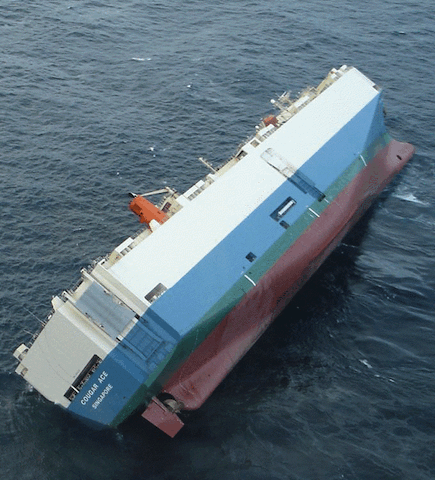I'm feeling much more stable!
I'm no longer hung over + I've survived three days of class + I completed my homework assignment before 5pm = I'm in a good mood + Now I want to blog! I am constantly worried that if I talk about ships too much my blog will be boring. My Mom has tried to convince me that it is actually interesting. Of course she says it's interesting!! She's my mom! Anyway, I'm going to write a bit about ships stability. (Please keep in mind that I'm a mathematical retard and that I'm still struggling with these concepts after 4 years at a maritime academy and 5 years sailing - it could be argued that this lack of proficiency could deem me unqualified for promotion - I'll refer back to this statement in my closing remarks.)
There are two principals which I consider to be the corner stone of the stability foundation. The Center of Gravity (G) and The Center of Buoyancy (B). The Center of Buoyancy refers to the forces acting 'upward' on the ships hull - this is also the center of the volume of the immersed portion of the hull - because why? well because the ship is in the water! The Center of Gravity refers to all the vertical 'downward' forces. These forces are a direct result of the cargo we are loading. When the vessel is underway the Center of Buoyancy (B) is constantly changing - this is because the ship is rolling from side to side and the portion of the hull in the water is changing. Because B is always changing it is important for you to be very aware of where your Center of Gravity (G) is located in relation to the Metacenter. I need to introduce one more vocabulary word: Transverse Metacenter (M). Transverse Metacenter is a point through which B acts vertically upwards as the vessel is inclined and B shifts to the low side - so, as B shifts to the low side you draw a vertical line - at some point the vertical line will intersect the centerline - this is M! The distance between G and M is called the Metacentric Height - on ships we call this GM - THIS IS WHAT WE CARE ABOUT! Of course we care about lots of other things too however, being unaware of your vessels GM could be disastrous. When we refer to GM we refer to it as positive, negative, or neutral. When I was a cadet it was explained to me like this: positive GM is like being a pyramid - all your weight is down low; negative GM is like being an ice cream cone - all your weight is up high - and if you let go it will topple over; neutral stability is like being a ball on a flat plane - any applied force can get you moving. Clearly, the idea here is to maintain positive GM. Because I have primarily sailed on tankers this hasn't been too big of an issue - why? because our weight is added down low due to the nature of the vessel. If you look at container ships or car carriers you can see that GM would be a much bigger concern. Case in point:
We have also spent a fair amount of time discussing shifting, adding and subtracting weights - any of these actions will invariably affect your draft, trim, and overall displacement - it will also change how the vessel behaves in a dynamic situation (i.e. at sea).
You may be asking yourself why I suddenly have an interest in stability. Traditionally each Deck Officer is responsible for various tasks: Third Mates are responsible for fire fighting and life saving equipment; Second Mates are responsible for the bridge - they are the vessels Navigator; Chief Mates are responsible for cargo - you can't be responsible for the cargo without also being responsible for the vessels stability! The Captain is responsible for the safe navigation of the vessel - which means he has a vested interest in making sure all Officers are performing their tasks satisfactorily - very little aboard a vessel doesn't affect the safe navigation of the vessel!
As a Junior Officer I have always been responsible for standing a cargo watch. I've participated in the loading and discharging process and am very comfortable overseeing the operation. The next step is being able to build a cargo plan taking into account stability and ensuring that the plan is being executed smoothly.
Earlier I added a qualifying statement to my self proclaimed incompetence. The solution to my problem can be solved very easily! It's called a Computer and it's loaded with Stability Software! I can simply enter all of data and it tells me what my GM is! I say take this tank down to 80% and that tank up to 100% and it tells me what my new drafts are! It's beautiful! I seriously doubt that in 6 months I could bust out all this crazy math - however, I would know where to go to find the formulas if my computer broke down and I understand the concepts much, much better. Et Voila! A Chief Mate in the making :)

